The state of Utah’s list of venomous snakes includes 7 different rattlesnakes. All species of rattlesnakes are members of the (Viperidae) or pit viper family. All pit vipers have triangular-shaped heads with vertical slit eye pupils. They also have a pit between their nostril and eyes on each side of their face.
We’ll discuss each of Utah’s rattlesnake species below. With this in mind, for a shortcut to a particular snake’s respective section, click on its link.
Coral snakes are venomous snakes from the Elapidae family, including cobras. Western coral snakes are native to the American desert southwest. However, officially, there are no coral snakes in Utah. Nonetheless, people sometimes make reports of Utah coral snakes.
These reports are likely cases of mistaken identity. The reason is that some snakes in Utah, like milk snakes, copy the color pattern of coral snakes. Even though experts say there are no coral snakes in Utah, we’ll discuss them later in this article. As with the rattlesnake species, if you’d like to skip to the section on coral snakes, click on their link.
- Mojave Rattlesnake (Crotalus scutulatus)
- Speckled Rattlesnake (Crotalus mitchellii)
- Grand Canyon Rattlesnake (Crotalus o. abyssus)
- Midget Faded Rattlesnake (Crotalus o. concolor)
- Great Basin Rattlesnake (Crotalus o. lutosus)
- Hopi Rattlesnake (Crotalus viridis nuntius)
- Mojave Desert Sidewinder (Crotalus cerastes)
- Western Coral Snake (Micruroides euryxanthus)
Utah Rattlesnakes
The first thing people think about with regard to rattlesnakes is their tails. With few exceptions, rattlesnakes have rattles on the ends of their tails. These rattles are made from loosely interlocked hollow sections of keratin. They vibrate their rattles when disturbed or needing to make a defensive display. This vibration makes a buzzing or rattling-type sound.
Sometimes, rattlers strike without rattling. Occasionally, their rattles fall off. While in rattlesnake country, you must be aware of where you place your hands and feet. If you hear a rattling noise, do not move until you spot where it originated. Otherwise, you may accidentally move into the snake, provoking it to strike you. Once you’ve spotted the snake, you can move away to a safe distance.
Rattlesnakes predominantly feed on small mammals such as such as rodents. Additionally, their diet sometimes includes small birds, amphibians, and reptiles.
The Utah Division of Wildlife Resources website states Utah law protects rattlesnakes. This law makes it illegal to harass or kill one. The only exception to this is if you are defending yourself.

Mojave Rattlesnake (Crotalus scutulatus)
Adult Mojave rattlesnakes typically measure 2 to 4 ft (about 0.61 to 1.22 m) in length. These snakes sport a base color that varies in shades of brown, olive green, dark green, and tan. Along their backs, they feature a distinctive dark brown diamond-like pattern. Their tails have white and black bands, adding to their unique appearance.
Other common names are Mojave Green Rattlesnake and Mohave Rattlesnake.
Where Do Mojave Rattlesnakes Live in Utah?
The Mojave Rattlesnake’s range in Utah is in Washington County. This is in the far southwest corner of the state. Mojaves prefer high deserts (500 – 5,000 ft. elevation) and lower mountain slopes. They like desert flats instead of areas with high volumes of vegetation or rocky areas.
How Dangerous Are Mojave Rattlesnakes?
Mojave Rattlesnakes have highly potent venom. They are one of the state of Utah’s most dangerous snakes.
Their venom is either hemorrhagic/hemotoxic or neurotoxic. The type of venom the snake has depends on the area it lives in. Their hemorrhagic venom prevents blood clotting and destroys body tissue. On the other hand, their neurotoxic venom is even more dangerous. It shuts down the nervous system. Victims of neurotoxic venom may become paralyzed. Furthermore, they can lose the ability to breathe. Source

Speckled Rattlesnake (Crotalus mitchellii)
Speckled Rattlesnakes vary a bit in color. They can be cream, tan, grey, bluish-grey, orange, or yellowish-pink. Their bodies look speckled due to the pattern of their scales. Speckled rattlesnakes are up to 39 in (100 cm) in length.
Other common names for this snake include Mitchell’s Rattlesnake and White Rattlesnake.
Where Do Speckled Rattlesnakes Live in Utah?
The Speckled Rattlesnake’s range in the “Beehive State” is in Washington County. This range is like the Mojave rattlesnakes. Yet, they live in different habitats from the Mojave. Speckled Rattlesnakes prefer rocky terrain with some vegetation. But Mojave Rattlesnakes live out on the desert flats.
How Dangerous Are Speckled Rattlesnakes?
A Speckled Rattlesnake’s venom is hemotoxic. It can lead to various symptoms. It can cause significant pain and swelling at the bite site, making it uncomfortable. Nausea and vomiting might also occur. It can affect blood clotting and lead to excessive bleeding. It may induce shock, leaving the victim feeling weak and disoriented. There’s also a possibility of mild paralysis. It’s crucial to seek immediate medical help if bitten by a Speckled Rattlesnake. Source
Western Rattlesnake (Crotalus oreganus)
The Western Rattlesnake is the most common rattlesnake in Utah. Three of the five Western Rattlesnake subspecies reside in the Beehive state. They are the Great Basin Rattlesnake, Midget-faded Rattlesnake, and Grand Canyon Rattlesnake.
Find out about each of Utah’s Western Rattlesnake subspecies below.
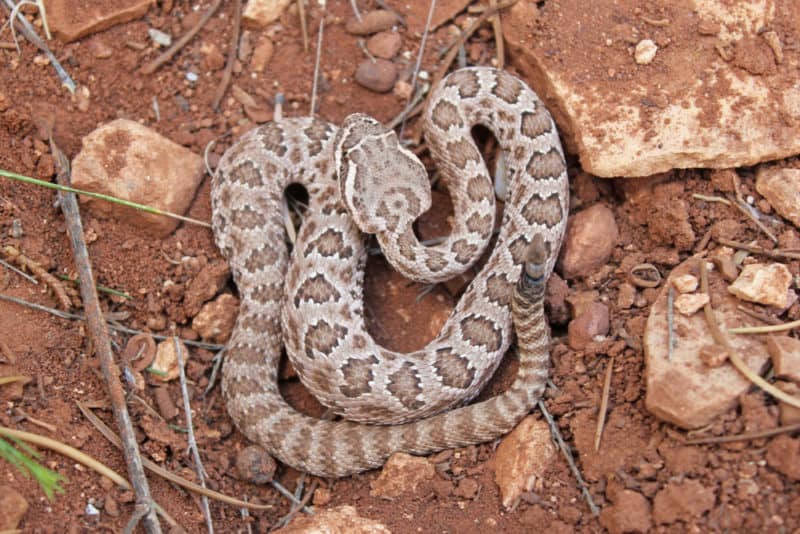
Grand Canyon Rattlesnake (Crotalus o. abyssus)
Adult Grand Canyon Rattlesnakes measure from 16 to 54 inches (41 to 137cm) long. Their base color varies from snake to snake. They may be pink, yellowish-green, tan, or gray. They have brown blotches down their back that turn into bands at the tail. Younger snakes generally have more prominent markings than adults. In fact, some adult Grand Canyon Rattlesnakes have no body markings.
Where Do Grand Canyon Rattlesnakes Live in Utah?
Grand Canyon Rattlesnakes live only in Northern Arizona and South-central Utah. To be more precise, they live in Utah’s Kane and Garfield Counties.
How Dangerous Are Grand Canyon Rattlesnakes?
The Grand Canyon Rattlesnake venom is a potent mix of neurotoxins and hemotoxins. Their bites may produce pain, edema, nausea, and vomiting. Furthermore, their venom’s hemotoxic component can cause internal bleeding and multiple organ damage. See
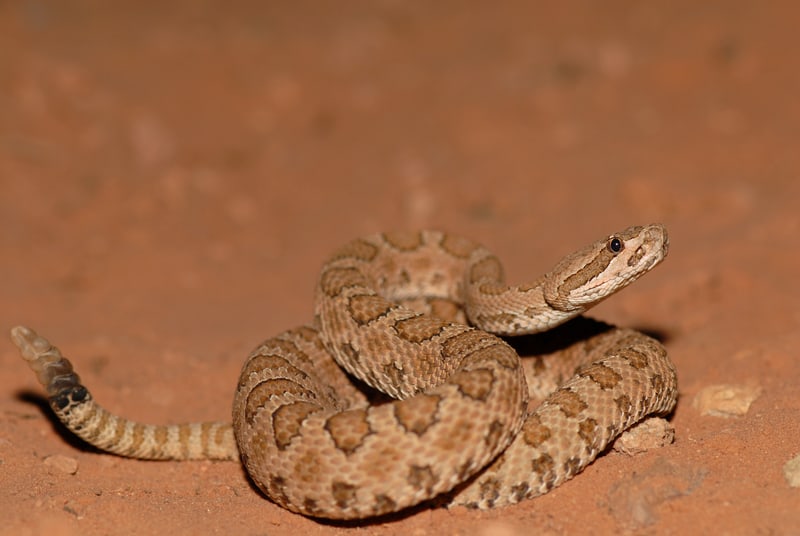
Midget Faded Rattlesnake (Crotalus o. concolor)
Midget Faded rattlesnakes are cream, brownish-grey, or a straw-like color. This species is a subspecies of the western rattlesnake. Adults grow from 20 to 30 inches (508 to 762mm) long. Males are usually longer and heavier than females.
Where Do Midget Faded Rattlesnake Live in Utah?
Midget Faded rattlesnakes inhabit eastern Utah, primarily on the Colorado Plateau. They prefer rocky hillsides with many places to hide amongst the rocks.
How Dangerous Are Midget Faded Rattlesnakes?
Midget Faded rattlesnake venom has strong neurotoxic properties. In fact, their venom is more toxic than that of some cobras. A bite from this snake interferes with the transmission of nerve impulses. Symptoms of neurotoxic envenomation include droopy eyelids, frothy saliva, and slurred speech. More serious effects include paralysis of the skeletal muscles and respiratory failure. Source Source
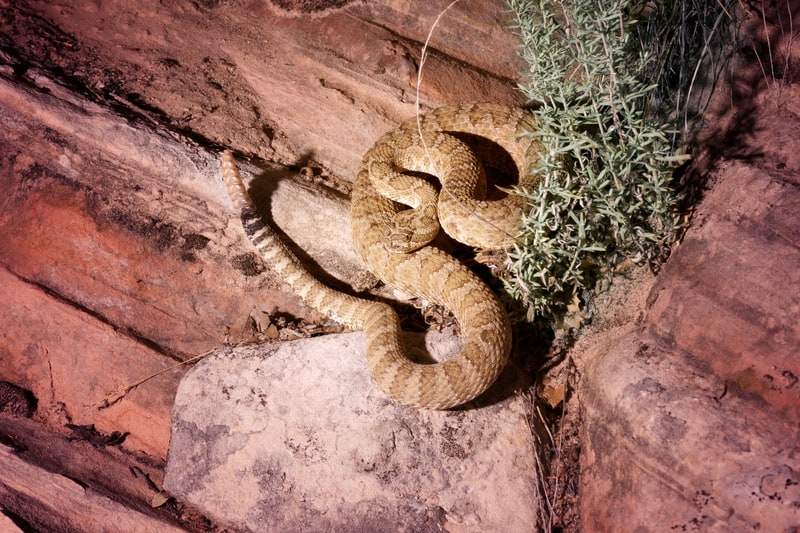
Great Basin Rattlesnake (Crotalus o. lutosus)
The Great Basin Rattlesnake is a subspecies of the Western Rattlesnake. See,
These snakes’ bodies are light grey or light brown. Their bodies are also covered with dark blotches. These blotches are dark brown to black with pale centers. These rattlesnakes rarely exceed 3 feet (.91 m) in length. However, the largest specimens grow to 4 feet (1.22 m).
Where Do Great Basin Rattlesnakes Live in Utah?
Great basin rattlesnakes have a variety of habitats in which they can live and survive. These include juniper forests, age-low banks, and rocky outcrops. This rattlesnake’s range in Utah takes in the state’s western half.
How Dangerous Are Great Basin Rattlesnakes?
The Great Basin Rattlesnake venom is a potent mix of myotoxins and hemotoxins. Their bites may produce pain, edema, nausea, and vomiting. Furthermore, their venom’s hemotoxic component can cause internal bleeding and multiple organ damage. Moreover, the myotoxic part of their venom will produce necrosis of body tissue. Source
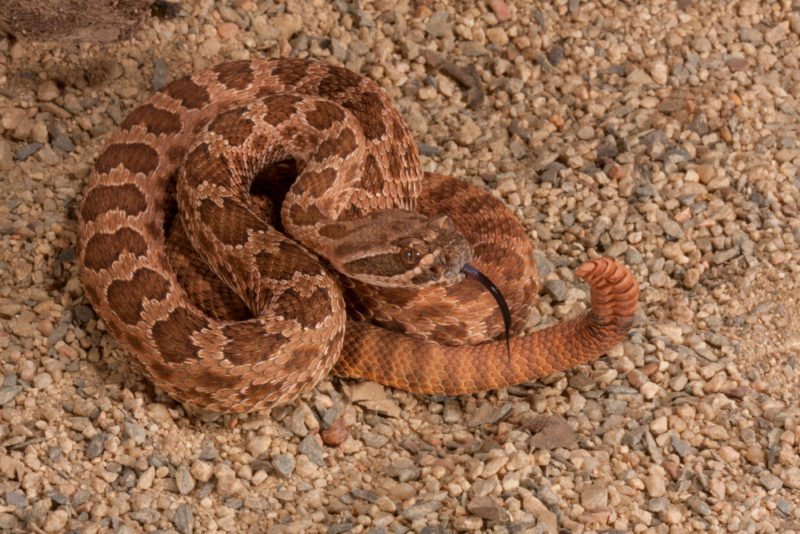
Hopi Rattlesnake (Crotalus viridis nuntius)
Hopi Rattlesnakes are a smaller subspecies of the Prairie Rattlesnake. Their body color varies with their natural surroundings. But it is generally pinkish brown to tan with darker brown blotches. Hopi rattlesnake adults grow up to 2 ft. long (60cm). These snakes are mostly ground snakes. But they occasionally climb into shrubs, bushes, or trees.
Other common names for this snake include Arizona Prairie Rattlesnake and Prairie Rattlesnake.
Where Do Hopi Rattlesnakes Live in Utah?
The Hopi Rattlesnake lives in the southeastern regions of Utah. They also live in Northern Arizona and New Mexico. Source
How Dangerous Are Hopi Rattlesnakes?
Their venom is both hemotoxic and neurotoxic.
Hopi Rattlesnake bites can have serious effects. The venom can cause intense and excruciating pain. It may also induce shock, making the victim feel weak and disoriented. Swelling, blistering, and inflammation can occur at the bite site. Nausea and vomiting may follow. Their venom can also damage red blood cells and impair blood clotting. In severe cases, the bite may result in severe tissue damage. There is also a risk of harm to internal organs. This makes a Hopi Rattlesnake bite a dangerous and potentially life-threatening situation. Source

Mojave Desert Sidewinder (Crotalus cerastes)
Mojave Desert Sidewinders are also known as Horned Rattlesnakes or Sidewinder Rattlesnakes. These snakes get their name for their peculiar sideways form of locomotion. They lead with their midsections instead of their heads. It turns out that this is a much more effective way to move across the sand. In fact, the sidewinder can reach speeds of up to 18 mph. The adult snake measures 17 to 31 inches (432 to 787 mm) in length, with the female being the largest. Their base color pattern varies. It can be cream, buff, yellowish-brown, pink, or ash gray, overlaid with 28-47 dorsal blotches. The belly is white, and the adult’s proximal lobe’s rattle is brown. Mojave sidewinders can change their color depending on the temperature. The process of doing this is known as metachrosis.
Where Do Mojave Desert Sidewinders Live in Utah?
Mojave Desert Sidewinders are native to the southwestern United States and northwestern Mexico. In Utah, they are found in the extreme southwestern corner of the state.
How Dangerous Are Mojave Desert Sidewinders?
The Sidewinder Rattlesnake is venomous, but its venom is weaker than other rattlesnakes. Their smaller venom glands make them less dangerous than their larger relatives. You should still be wary of them because any rattlesnake bite can be fatal. If bitten, you should seek medical attention immediately.
SideWinder rattlesnakes can’t inject enough venom with one bite to create severe complications. However, it’s more serious if the victim gets envenomated multiple times. If medical treatment is delayed, the following complications could occur.
- Internal bleeding
- Deep tissue damage may lead to bacterial infections and gangrene.
- Loss of use of the affected limb
- Severe shock
- Paralysis
- Seizures
- Coma
- Multiple organ failure source
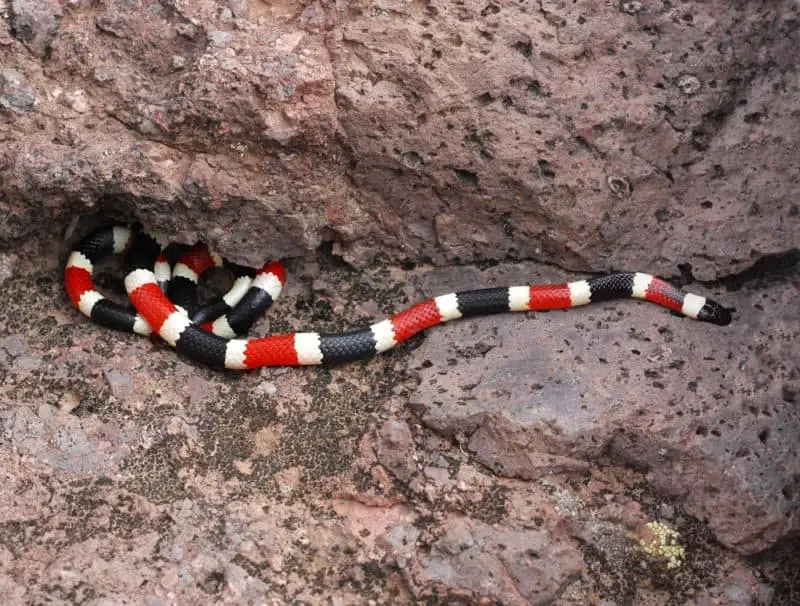
Western Coral Snake (Micrurus tener)
The Western Coral snake is a small, skinny snake (as skinny as a pencil) reaching between 13 to 21 inches (330.2 to 533.4 mm). They are sexually dimorphic, with the males being slightly smaller than the females. They have rounded heads and noses with similar-looking tails. Consequently, it is sometimes hard to tell a coral snake’s head from its tail.
Coral snakes are members of the Elapidae family. Elapid snakes have round pupils. This differs from the majority of venomous snakes in the U.S., which are pit vipers. Pit vipers have vertical slit pupils.
Coral snakes are brightly colored, highly venomous snakes. They have black, light yellow, and red bands, with the yellow bands separating the red and black.
Batesian Mimicry Of Coral Snakes
Batesian mimicry is a biological term. It describes how a harmless species protects itself by resembling a dangerous one. For example, the scarlet king snake and the milk snake are non-venomous snakes. However, their color patterns closely resemble the venomous coral snake. The difference is that a coral snake’s red and yellow bands touch. On the other hand, the non-venomous species’ color patterns are red, black, and yellow. Also, a coral snake’s head is blunt and entirely black, even behind its eyes, while a Kingsnake’s head is red. This is the best way to identify them.
This rhyme helps people distinguish between a nonvenomous species and a coral snake. “Red and yellow can kill a fellow; Red touch black, a friend of Jack.”
The rhyme is mostly accurate in the United States. However, coral snakes from areas south of the U. S. do not always follow the black-yellow-red pattern. This is also true in Central America, South America, and the Caribbean.
Finally, there are rare coral snakes that do not follow the usual color pattern in the United States. Pink, cream-colored, light blue, and completely black coral snakes exist in the wild.
How Dangerous Are Coral Snakes?
Coral snakes are highly venomous snakes. In fact, herpetologists regard them as the most venomous snakes in the United States. Fortunately, they almost never bite.
Coral snake venom is a neurotoxin and is the second strongest of any snake. The experts consider coral snakes to be less dangerous than rattlesnakes, though. Their smaller mouths and short fangs produce less venom. Thus, they have a less effective venom delivery system.
People should take coral snake bites seriously, though. Before we had antivenom, the death rate after coral snake envenomation was around 10%. See
Symptoms of Venomous Snake Bites
Some of the symptoms you may experience from a venomous snake bite include:
- Discoloration in the area of the bite.
- Swelling in the area of the bite.
- Loss of muscle coordination.
- Tingling sensation in the area of the bite.
- Feeling nauseous.
- Having an abnormally rapid pulse.
What Should You Do If A Venomous Snake Bites You?
If you or someone you are with has suffered a venomous snakebite, time is of the essence. This is because the sooner a victim receives anti-venom, the less likely the venom in their body is to cause harm. In other words, it is important to seek immediate medical attention.
Do not attempt to kill the snake for identification purposes. This gives the snake a chance to bite you again. Also, consider that severed snakeheads can still bite and envenomate. If you have a phone, take a picture of the offending reptile. Otherwise, get started on your way to the doctor.
First Aid for Snake Bite Victims
- Remain calm and limit your movements. Do not run. If you must hike back to a vehicle, do it calmly and deliberately. Put as little stress on your heart as possible.
- Keep the area of the snake bite below the heart level and never above the heart level. Keeping the bite below the heart level will reduce the venom’s flow. However, holding the bite above your heart level will increase the venom’s flow.
- Remove all constricting items such as bracelets, watches, or rings before swelling occurs.
- Remember that using a cold compress on a venomous snake bite is not advisable. The cold may cause the local blood vessels to constrict and spread the venom faster.
- You can wash the affected area like any other wound with soap and water.
- You may cover the bite area with a moist dressing to reduce the swelling.
- Get medical attention as soon as possible. Call the hospital to tell them a venomous snake has bitten you. So they can have anti-venom ready to give you when you arrive.
- A person whom a venomous snake has bitten may go into shock. If this happens, lay them flat and cover them with a blanket.
Dressing for Snake Country
- High-top leather boots and long pants are both wise ideas.
- Also, wear loose-fitting denim. If there’s a gap before the snake’s fangs touch your skin, your chances of being envenomated are lower.
- In the absence of high-top leather boots, some people wear snake gaiters.
Recent Posts
The only venomous snakes in Washington State are Northern Pacific Rattlesnakes. The Northern Pacific Rattlesnake (Crotalus oreganus oreganus) is a sub-species of the Western Rattlesnake. Anyone...
Skunks are not classified as true hibernators. But they go into a state of torpor when the weather gets cold. Skunks are light sleep hibernators, along with opossums, bears, and raccoons. ...

